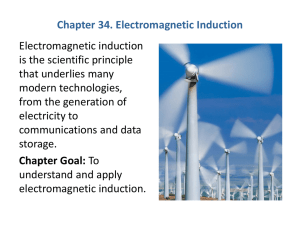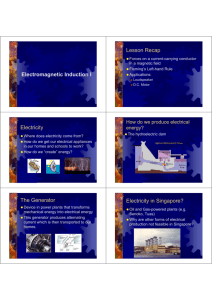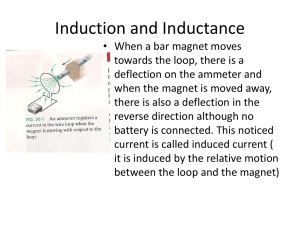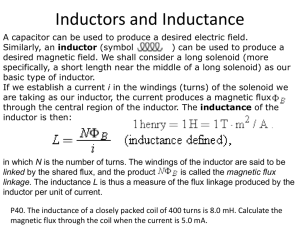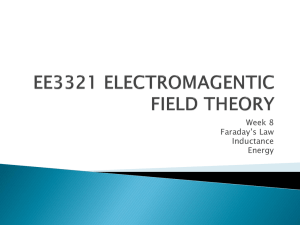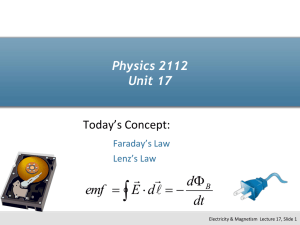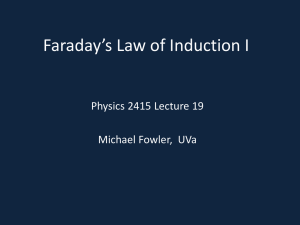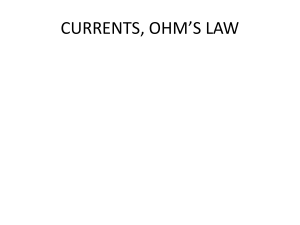Ch 30 Induction and Inductance
advertisement
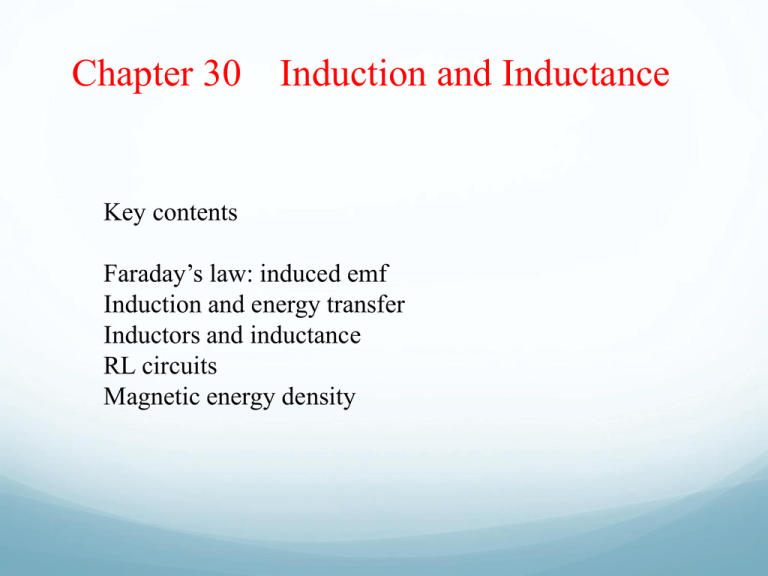
Chapter 30 Induction and Inductance Key contents Faraday’s law: induced emf Induction and energy transfer Inductors and inductance RL circuits Magnetic energy density 30.2: The First Experiment: 1. A current appears only if there is relative motion between the loop and the magnet (one must move relative to the other); the current disappears when the relative motion between them ceases. 2. Faster motion produces a greater current. 3. If moving the magnet’s north pole toward the loop causes, say, clockwise current, then moving the north pole away causes counterclockwise current. Moving the south pole toward or away from the loop also causes currents, but in the reversed directions. The current thus produced in the loop is called induced current. 30.2: The Second Experiment: For this experiment we use the apparatus of Fig. 30-2, with the two conducting loops close to each other but not touching. If we close switch S, to turn on a current in the right-hand loop, the meter suddenly and briefly registers a current—an induced current—in the left-hand loop. If we then open the switch, another sudden and brief induced current appears in the left hand loop, but in the opposite direction. We get an induced current (and thus an induced emf) only when the current in the righthand loop is changing (either turning on or turning off) and not when it is constant (even if it is large). 30.3: Faraday’s Law of Induction: The magnetic flux is If the loop lies in a plane and the magnetic field is perpendicular to the plane of the loop, and if the magnetic field is constant, then The SI unit for magnetic flux is the tesla–square meter, which is called the weber (abbreviated Wb): 30.3: Faraday’s Law of Induction: Example, Induced emf in a coil due to a solenoid: 30.4: Lenz’s Law: Opposition to Pole Movement. The approach of the magnet’s north pole in Fig. 30-4 increases the magnetic flux through the loop, inducing a current in the loop. To oppose the magnetic flux increase being caused by the approaching magnet, the loop’s north pole (and the magnetic moment m) must face toward the approaching north pole so as to repel it. The current induced in the loop must be counterclockwise in Fig. 30-4. If we next pull the magnet away from the loop, a current will again be induced in the loop. Now, the loop will have a south pole facing the retreating north pole of the magnet, so as to oppose the retreat. Thus, the induced current will be clockwise. Example, Induced emf and current due to a changing uniform B field: Example, Induced emf and current due to a changing nonuniform B field: 30.5: Induction and Energy Transfers: The induced current is therefore The net deflecting force is: The power is therefore , which is exactly equal to i2R. The work done (mechanical energy) is converted to thermal energy. 30.5: Induction and Energy Transfers: Eddy Currents Many applications: braking, heating, magnetic levitation… 30.6: Induced Electric Fields: 30.6: Induced Electric Fields, Reformulation of Faraday’s Law: ò (Ñ ´ E)·da = ¶B Ñ´E = ¶t ¶ ò B· da ¶t (Faraday’s law in differential form) 30.6: Induced Electric Fields, A New Look at Electric Potential: The integration over a closed path is NOT zero! The induced electric force is not a conservative force! Example, Induced electric field from changing magnetic field: Example, Induced electric field from changing magnetic field, cont.: 30.7: Inductors and Inductance: An inductor (symbol ) can be used to produce a desired magnetic field. If we establish a current i in the windings (turns) of the solenoid which can be treated as our inductor, the current produces a magnetic flux FB through the central region of the inductor. The inductance of the inductor is then The SI unit of inductance is the tesla– square meter per ampere (T m2/A). We call this the henry (H), after American physicist Joseph Henry. 30.7: Inductance of a Solenoid: Consider a long solenoid of cross-sectional area A, with number of turns N, and of length l. The flux is Here n is the number of turns per unit length. The magnitude of B is given by: Therefore, The inductance per unit length near the center is therefore: 30.8: Self-Induction: 30.9: RL Circuits: Á - iR - L di =0 dt L di + iR = Á dt Recall that If we suddenly remove the emf from this same circuit, the current does not immediately fall to zero but approaches zero in an exponential fashion: 30.9: RL Circuits: di Á -t/t L = e dt L # Check the high- and low-potential points. Example, RL circuit, immediately after switching and after a long time: Example, RL circuit, during a transition: 30.10: Energy Stored in a Magnetic Field: This represents the total energy stored by an inductor L carrying a current i. Example, Energy stored in a magnetic field: 30.11: Energy Density of a Magnetic Field: Consider a length l near the middle of a long solenoid of cross-sectional area A carrying current i; the volume associated with this length is Al. Ch. 29: 30.12: Mutual Induction: The mutual inductance M21 of coil 2 with respect to coil 1 is defined as The right side of this equation is, according to Faraday’s law, just the magnitude of the emf E2 appearing in coil 2 due to the changing current in coil 1. Similarly, # It can be shown that we always have Example, Mutual Inductance Between Two Parallel Coils: Example, Mutual Inductance Between Two Parallel Coils, cont.: Homework: Problems 11, 24, 42, 57, 75
